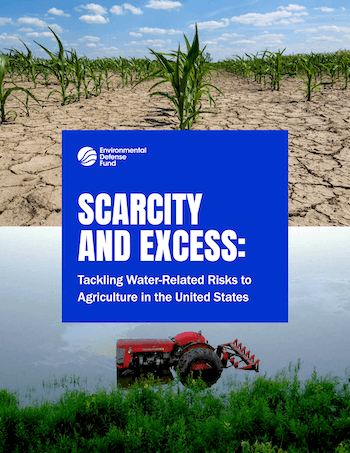Report: Escalating Water Risks Threaten U.S. Agriculture
Pathways to climate-smart adaptation require urgent public-private support
(December 8, 2023, Washington, D.C.) Deepening patterns of water scarcity and excess pose a growing threat to agriculture across much of the United States according to a new report from the Environmental Defense Fund.
The study finds intensifying climatic extremes — combined with accelerating disruptive human interventions, including groundwater over-extraction, sprawling drainage networks and misaligned governance — are driving mounting water-related agricultural costs, particularly in midwestern and western states.

“Water risks increasingly form the most critical threat to food and fiber production in the United States,” said Rachel O’Connor, senior manager of Climate Resilient Water Systems, Environmental Defense Fund and a lead author of the report. “There are, however, a number of emerging pathways to counteract these threats. New technology and data platforms can significantly improve on-farm water management. Investments in aquifers as natural infrastructure can boost both drought and flood resilience. Perhaps most critically, partnerships and collaboration are vital to developing durable solutions that address the problem at scale.”
“Agriculture in the United States must adapt to intensifying patterns of water scarcity and excess,” said Kelly Suttles, senior research analyst, Climate-Smart Agriculture, Environmental Defense Fund and a lead author of the report. “We’ve identified a number of promising adaptation strategies, including transitioning to alternative, economically viable crops and on-farm water recycling, that can boost both drought and flood resilience. For these strategies to take root, however, public and private sector leaders must ensure climate-smart agriculture financing solutions become readily accessible nationwide.”
Drought and riverine flooding alone caused an estimated $2 billion in annual losses to the agriculture sector in the West and Midwest according to the Federal Emergency Management Agency’s National Risk Index. Excess water caused $10 billion dollars in damage to the U.S. corn crop from 1989-2016.
In addition to an overall analysis of water-related threats to agriculture, the report — outlines a number of projected region-specific impacts:
- California’s Sierra Nevada snowpack, the lynchpin of the state’s extensive agriculture sector, is projected to experience a 48-65% decline from the historical average by 2100.
- The Pacific Northwest’s Yakima Basin, under a severe warming scenario, faces significant predicted drops in average annual yields of key crops, including potato, alfalfa and apple.
- In the Southwest, further reduction in snowmelt is predicted to increase reliance on groundwater, placing unsustainable stress on the region’s already overtaxed aquifers.
- Kansas faces predicted declines in both groundwater and surface water due to climate-driven decreases in precipitation, increased groundwater withdrawals and rising evaporative losses.
- The Midwestern Cornbelt’s predicted increase in extreme weather — including both excessive rainfall and high temperatures — could combine to significantly disrupt crop production.
The authors suggest a multi-pronged response to these growing threats. Their analysis identifies promising pathways to sustainable adaptation via:
- Land and crop management changes, including multi-benefit land repurposing, transitions to climate-resilient crop mixes and further development of soil health practices.
- Technology and decision-support tools, including OpenET, an open-access data platform that provides field-level satellite-based evapotranspiration data; and the Groundwater Accounting Platform, a new platform for managers, growers and water users to track water availability and use in near real-time.
- Built and natural infrastructure approaches, including on-farm water recycling and natural infrastructure for drought and flood resilience.
- Policy and funding mechanisms. Including climate-smart groundwater governance and financing solutions to support climate-smart agriculture investments.
The full report, including five in-depth case studies from across the midwestern and western United States, can be found here. Explore this and additional climate impacts on food production and water supplies.
With more than 3 million members, Environmental Defense Fund creates transformational solutions to the most serious environmental problems. To do so, EDF links science, economics, law, and innovative private-sector partnerships to turn solutions into action. edf.org
Media Contact
Latest press releases
-
New Seafood Executive Order Puts American Seafood Competitiveness At Risk
April 18, 2025 -
California Must Lead on Climate Action through Cap-and-Trade Extension this Year
April 15, 2025 -
Reports: Trump Administration Plans Detrimental Cuts to NOAA Climate Research
April 11, 2025 -
Senate Bill Would Reduce Risk of Catastrophic Wildfires
April 11, 2025 -
EPA Reportedly Plans to Stop Collecting Data about Climate Pollution
April 11, 2025 -
IMO's Climate Diplomacy Sets the Course for the Shipping Sector’s Energy Transition
April 11, 2025










